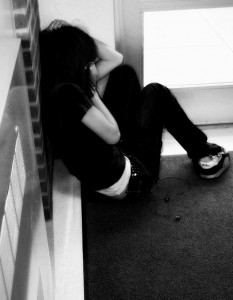living with borderline personality disorder

Image via WIkimedia Commons
Author’s Note: Please remember while reading this that these are my own personal thoughts and experiences and they do not represent everyone with a diagnosis of BPD. Please follow the links provided for more information.
Writing a concise piece on a very misunderstood and stigmatised mental illness is no easy feat. When you speak or write publicly about mental illness, you need to be very careful with the language you use, as that is the information that most of the public feed off to form their views of mental illness. This is why media coverage as well as films and television can be incredibly damaging, because, while likely to be unintentional, it tends to only further stigmatise mental illness and the people who struggle with it.
Hello, my name is Ruth, I’m 24 years old, and I have Borderline Personality Disorder (BPD).
I’m pretty sure that the first thing people think of when they hear these words is the movie Girl, Interrupted. It is one of the few pieces of cinema out there that depicts someone who has been diagnosed with BPD. However, a word of caution; fictional films are not fact. If you are a fan of the film, I encourage you to read the memoir by Susanna Kaysen, of the same name, that the film is based on. As with most films that are based on books, there are many important factors in the book that the film fails to convey.
A bit of personal history: I was first diagnosed with Major Depressive Disorder (Depression) and Generalized Anxiety Disorder (Anxiety) when I was 17 and in my second year of college. It was not until I was 23 that I was diagnosed with Borderline Personality Disorder once it was clear that I was, in fact, getting worse and that some of my symptoms did not fit my original diagnosis. Both depression and anxiety are very likely to co-occur with BPD, and many people diagnosed with BPD often have other diagnoses as well, as in my case.
I want to clear a few things up. No, having BPD doesn’t mean you are promiscuous (which we all know is a heavily gendered term anyway). It does not make you an attention seeker. It does not mean you are a manipulative psycho. It does not mean you cannot have stable, healthy relationships. You don’t have to be female to receive a diagnosis of BPD, although it is more often women diagnosed with the disorder (some further info on this can be found here). It does not mean you are completely dysfunctional. Most importantly, it can definitely be treated!
To be diagnosed with BPD you must show persistent and pathological patterns in a majority of the following ways: sudden and extreme mood changes, impulsive behaviour, difficulty with interpersonal relationships, particularly when fearing abandonment, confusion identity, uncontrollable anger, recurring suicidal or self-mutilating behaviour, and feelings of numbness or emptiness.
There are huge variations in presentation of BPD, and it is important to remember that not all people diagnosed with the disorder are the same. They most definitely aren’t. While this seems obvious, most people tend to base their beliefs on their own experiences, often projecting those beliefs onto someone else with the same diagnosis. This is extremely unhelpful, not just to mental illness but in many other areas as well. We all know stereotypes exist for a reason, but we must always remember not to treat them as rules.
One of the most stigmatised and misunderstood aspects of BPD is self-harm. While you do not have to self-harm to receive this diagnosis, it is a sad reality for many of its sufferers, myself included. One of the first posts I ever wrote on my personal blog was about self-harm, and I encourage you to check it out. It should be noted that this post comes with a strong trigger warning for frank depictions of self-harming behaviour and thoughts, and distorted views of body image that may upset some people. If you simply want some helpful information, please go here.
Since receiving this diagnosis, I have found accessing treatment to be difficult. The persistent stigma and stereotypes surrounding BPD are deeply entrenched, almost especially within the mental health system itself, which is supposed to be there to support you. Some health professionals still deny the existence of BPD and boil it down to attention seeking and manipulation. Unfortunately, people with BPD tend to be frequent presenters to hospital, and are often poorly treated because of their diagnosis, even more so if they are self-harmers.
It’s not all grim news though. Recovery from BPD can most definitely happen! More and more therapists and mental health professionals are gaining the skills needed to treat people with this disorder, and there are growing numbers of effective treatments available. There is definitely a long way to go, but there is hope, and I’m holding onto that hope ferociously because I, and others with BPD, deserve to be treated with equal care and respect and be able to lead a rich and fulfilling life.
If you feel the need to talk to someone, please contact Lifeline on 131 114, or you can chat to someone online between 7pm and 4am EST. If you are a young person seeking treatment, please visit the Headspace website to find your nearest centre.
For further information on BPD, you can visit the Spectrum website.

